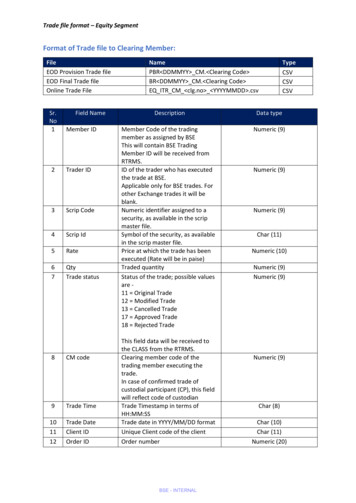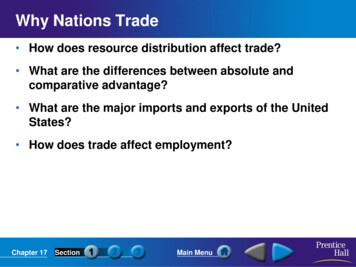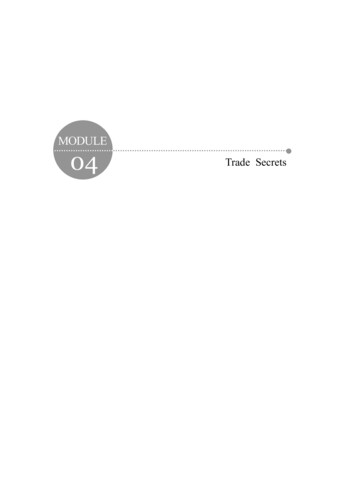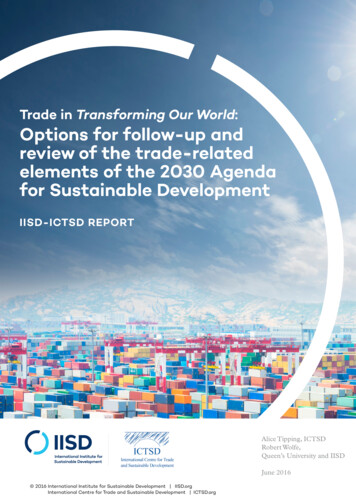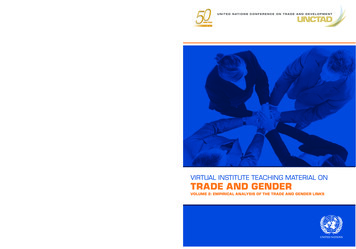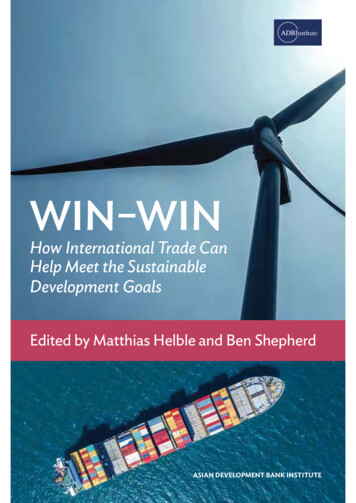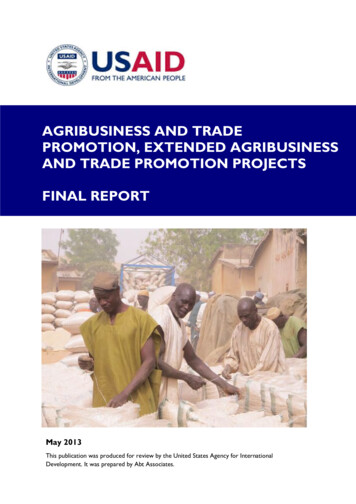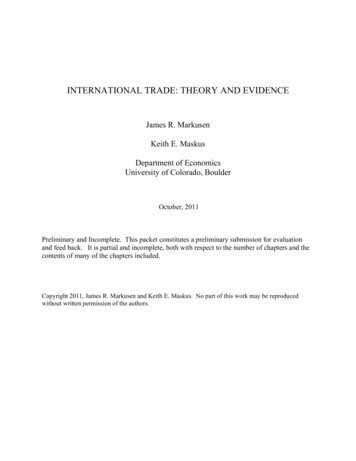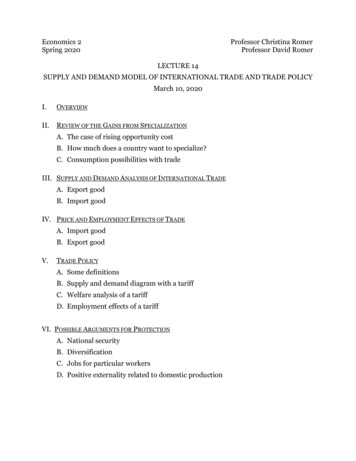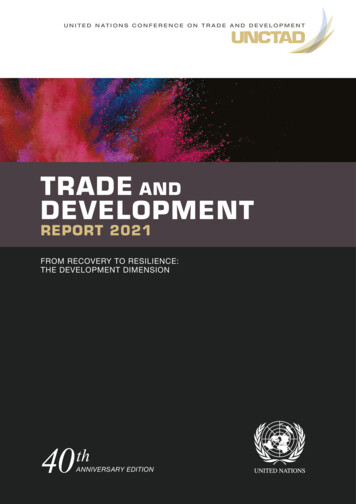
Transcription
U N I T E D N AT I O N S C O N F E R E N C E O N T R A D E A N D D E V E L O P M E N TTRADE ANDDEVELOPMENTREPORT 2021FROM RECOVERY TO RESILIENCE:THE DEVELOPMENT DIMENSION40thANNIVERSARY EDITION
UNITED NATIONS CONFERENCE ON TRADE AND DEVELOPMENTTRADE AND DEVELOPMENTREPORT 2021FROM RECOVERY TO RESILIENCE:THE DEVELOPMENT DIMENSIONReport by the secretariat of theUnited Nations Conference on Trade and DevelopmentUNITED NATIONSGeneva, 2021
2021, United NationsAll rights reserved worldwideRequests to reproduce excerpts or to photocopyshould be addressed to the Copyright ClearanceCenter at copyright.com.All other queries on rights and licences, includingsubsidiary rights, should be addressed to:United Nations Publications,405 East 42nd Street,New York, New York 10017,United States of AmericaEmail: publications@un.orgWebsite: https://shop.un.org/The designations employed and the presentationof material on any map in this work do not implythe expression of any opinion whatsoever on thepart of the United Nations concerning the legalstatus of any country, territory, city or area or ofits authorities, or concerning the delimitation ofits frontiers or boundaries.This publication has been edited externally.United Nations publication issued by theUnited Nations Conference on Trade and Development.UNCTAD/TDR/2021Sales No. E.22.II.D.1ISBN: 978-92-1-113027-0eISBN: 978-92-1-001027-6ISSN: 0255-4607eISSN: 2225-3262
TRADE AND DEVELOPMENT REPORT 2021FROM RECOVERY TO RESILIENCE: THE DEVELOPMENT DIMENSIONContentsExplanatory notes . ixAbbreviations . xOVERVIEW .I–XIIIChapter 1GLOBAL TRENDS AND PROSPECTS:POSITIVE VIBRATIONS OR WAITING IN VAIN?. 1A. Introduction. 1B. The Global Economy: Building Back Separately?. 21. Global growth prospects . 22. Inflationary Pressures: Nothing to Fear but Fear Itself. 63. Fiscal Policy and Public Debt. 104. Timing counter-cyclical measures or targeting development?. 14C. Global Finance and Developing Country Vulnerabilities . 171. Debt sustainability in developing countries: No sign of relief on the horizon. 21D. Trends in International Trade. 241. Goods and services. 242. Commodity markets. 28E. Regional Trends . 311. North America and Europe. 313. The Russian Federation and Central Asia. 334. East Asia . 345. South Asia. 356. South-East Asia. 357. Western Asia. 369. Africa. 37Notes. 38References. 40Annex: Methodological Note for Box 1.1. 44Chapter 2THE TROUBLED HISTORY OF BUILDING BACK BETTER:FROM THE 1980S DEBT CRISIS TO COVID-19.45A. Introduction. 45B. The Trade and Development Report at 40. 461. Swimming Against the Tide. 462. A Lost Decade. 473. Birth of the Hot. 484. Winners and Losers. 495. Growth Picks up; Imbalances Widen. 516. A Feature not a Flaw. 527. A New Normal versus a New Deal. 538. Back to the Future. 54iii
C. Living in the Past. 551. The growth picture. 562. The triggers of the slowdown. 573. Unfavourable conditions for most developing regions. 584. Overcoming the dilemmas of interdependence. 61D. From Economic Recovery to Building Back Better. 621. Avoiding separate development. 632. Taming the rentiers. 663. Making green recovery packages work. 68E. Towards a new economic settlement . 73Notes. 76References. 77Annex. 82Chapter 3IT’S THE END OF THE WORLD AS WE KNOW IT:SURVEYING THE ADAPTATION LANDSCAPE.83B. Measuring up to the adaptation challenge. 841. Slowing growth, widening gaps. 862. Sectoral and regional impacts. 873. The Economic Costs of Adaptation. 89C. The disarticulated architecture of climate governance. 91D. Climate adaptation: Risky business?. 95E. Conclusion . 98Notes. 99References. 99Chapter 4FROM DE-RISKING TO DIVERSIFICATION:MAKING STRUCTURAL CHANGE WORK FOR CLIMATE ADAPTATION.105A. Introduction . 105B. The Lewis model of development for a climate-constrained world. 1061. Capital investment . 1072. State Capacity . 1083. Linkages. 109C. Climate change, development and post-Covid recovery . 110D. Policies to combine structural transformation and climate adaptation strategies. 1151. Industrial policy revisited. 1162. Fiscal policy. 1203. The role of central banks. 1204. Towards a green developmental state. 122E. Conclusion. 124Notes. 125References. 126Chapter 5ADAPTATION GOVERNANCE:CHALLENGES IN INTERNATIONAL TRADE AND FINANCE.133A. Introduction . 133iv
B. Climate adaptation and the international trading system. 1341. Trade and environment in the WTO and other trade agreements. 1342. Carbon border adjustment mechanism in the era of global value chains. 1363. Push to liberalize environmental goods and services. 1384. Can international trading rules promote the circular economy? . 1405. The way forward on the trade and environment agenda. 140C. Financing climate adaptation: issues, instruments, institutions. 1421. The role of ODA and climate funds . 1432. Debt relief for adaptive development. 1443. The topography of green finance: instruments and institutions. 147D. Banks and climate finance. 1501. Dedicated green banks. 1502. Multilateral development banks with a climate change agenda. 151E. Policy recommendations. 154F. Conclusion. 156Notes. 156References. 158v
List of figuresFigure1.2 The economic impact of GFC, 2009–2010, vs. Covid-19, 2020–2021. 41.1 World output level, 2016–2022. 41.3 Real income growth, selected countries, 2021 over 2019. 51.4 Real GDP and personal consumption expenditures in the United States, 2019–2021. 61.5 Employment-population ration in the United States, January 2005–July 2021. 61.6 Consumer inflation, selected economies, December 2005–December 2020. 71.7 Variation in exchange rate of selected currencies vis-à-vis the dollar of the United States,selected time periods,1 Jan. 2020–30 Jul. 2021. 81.8 Consumer inflation in the United States and the euro area. 81.9 Price gap from a 2 per cent inflation trend, selected economies, December 2005–April 2021. 91.10 Ten year break even inflation in the United States. 91.11 Real wage in the United States, January 1979–March 2021. 91.12 Additional primary outlays in 2020 relative to inherited debt ratios indeveloping and developed economies. 131.13 Public and private investment in selected country groups, 1995–2016. 141.14 Net private capital flows to developing countries, 2017–2021. 171.15 Total external debt to export revenues, developing countries, 2009–2020. 221.16 Sovereign bond repayment profiles, selected regions, 2021–2030. 231.17 Gross government debt to government revenues, selected developing country regions and .advanced economies, 2000–2026. 241.18 World merchandise trade, January 2015–May 2021. 251.19 Metric tons of world exports by vessel type, 1 January 2020–31 May 2021. 261.20 Monthly commodity price indices by commodity group, January 2002–May 2021. 292.1 The slowdown in global economic growth, 1971–2020. 492.2 Main drivers of the scenario: global aggregates, 2001–2030. 572.3 Current account, selected groups, 2001–2030. 592.4 Private and public sectors net lending, 2001–2030. 602.5 Projected growth performance according to macro-financial patterns, 2022–2030. 612.6 Housing, shares and output in developed countries, first quarter 2000 to first quarter 2021. 642.7 Labour share in the United States in the aftermath of recessions. 642.A.1 Stock and housing appreciations in selected countries, first quarter 2000 to first quarter 2021. 823.1 Disaster impacts 2000–2019 relative to 1980–1999. 843.2 The Risk of Catastrophic Events Increases with Temperature. 863.3 Mid-century GDP losses by region generated by global warming. 875.1 CO2 emissions in domestic final demand and gross exports, OECDand non-OECD countries, 2015. 1365.2 Growth in CO2 emissions in gross exports and gross imports of OECD-countriesfrom non-OECD countries, 2005–2015. 1375.3 Adaptation vs Mitigation finance estimates . 1445.4 Green bonds: accumulated issuances, 2014–2020. 148Box FigureB1.1B1.2viEstimated size of Covid-19 fiscal stimuli, 2020. 11Proposed 2021 SDR allocation to developing country groups. 19
B1.3 Utilization of existing SDR allocations by country group, as of 31 May 2021. 205.B1.1 LICs, MICs and V20 country groupings – Indicators of external debt sustainability, 2019. 1465.B1.2 Climate-vulnerable and ready for adaptation* countries, percentage by country group, 2019. 147List of tables and boxesTable1.1 World output growth, 1991–2022. 31.2 World primary commodity prices, 2008–2021. 302.1 Average annual per capita growth, by region 1951–2020. 502.2 Economic growth of world regions, 2001–2030. 562.3 CO2 Emissions and Economic Growth for China, United States and the European Union,1999–2018. 693.1 Top ten countries and territories by economic losses as % of GDP. 883.2 Potential areas of intervention for climate adaptation. 925.1 Top exporters of environmentally related goods. 1385.2 Tariff revenue from environmental goods, developing economies, 2019. 1395.3 Stock and flows of climate finance (by donor reports). 1435.4 MDBs Climate finance components, 2020. 1525.5 Climate co-financing partners to MDBs, 2020. 1525.6 Summary of the financing landscape. 153Box Table5.B1.1 Projected SDR allocations – all LICs and MICs and the V20. 146Box1.11.21.31.43.15.15.2Fiscal stimuli in 2020: An ex-post assessment. 11The rocky road to public debt sustainability: A developmental perspective. 15Money for something: Moving on to an expanded role for Special Drawing Rights . 19Increased food insecurity amid rising food prices . 38National Adaptation Programmes of Action (NAPAs). 90Shades of vulnerability – Climate, finance and SDG dimensions facing the V20 countries. 145What makes a bank green?. 149vii
viii
Explanatory notesClassification by country or commodity groupThe classification of countries in this Report has been adopted solely for the purposes of statistical oranalytical convenience and does not necessarily imply any judgement concerning the stage of developmentof a particular country or area.There is no established convention for the designation of “developing”, “transition” and “developed”countries or areas in the United Nations system. This Report follows the classification as defined in theUNCTAD Handbook of Statistics 2020 (United Nations publication, Sales No. E.21.II.D.1) for these threemajor country groupings (see https://unctad.org/en/PublicationsLibrary/tdstat45 en.pdf).For statistical purposes, regional groupings and classifications by commodity group used in this Report followgenerally those employed in the UNCTAD Handbook of Statistics 2020 unless otherwise stated. The datafor China do not include those for Hong Kong Special Administrative Region (Hong Kong SAR), MacaoSpecial Administrative Region (Macao SAR) and Taiwan Province of China.The terms “country” / “economy” refer, as appropriate, also to territories or areas.References to “Latin America” in the text or tables include the Caribbean countries unless otherwise indicated.References to “sub-Saharan Africa” in the text or tables include South Africa unless otherwise indicated.Other notesReferences in the text to TDR are to the Trade and Development Report (of a particular year). For example,TDR 2020 refers to Trade and Development Report 2020 (United Nations publication, Sales No. E.20.II.D.30).References in the text to the United States are to the United States of America and those to the UnitedKingdom are to the United Kingdom of Great Britain and Northern Ireland.The term “dollar” ( ) refers to United States dollars, unless otherwise stated.The term “billion” signifies 1,000 million.The term “trillion” signifies 1,000,000 million.The term “tons” refers to metric tons.Annual rates of growth and change refer to compound rates.Exports are valued FOB and imports CIF, unless otherwise specified.Use of a dash (–) between dates representing years, e.g. 2019–2021, signifies the full period involved,including the initial and final years.An oblique stroke (/) between two years, e.g. 2019/20, signifies a fiscal or crop year.A dot (.) in a table indicates that the item is not applicable.Two dots (.) in a table indicate that the data are not available, or are not separately reported.A dash (–) or a zero (0) in a table indicates that the amount is nil or negligible.Decimals and percentages do not necessarily add up to totals because of rounding.ix
AbbreviationsBEPSBase Erosion and Profit ShiftingBISBank for International SettlementsBRICSBrazil, Russian Federation, India, China and South AfricaCCRTCatastrophe Containment and Relief TrustCDOsCollateralized Debt ObligationsCISCommonwealth of Independent StatesCLOsCollateralized Loan ObligationsCPBNetherlands Bureau for Economic Policy AnalysisCRAscredit rating agenciesDSSIDebt Service Suspension InitiativeECBEuropean Central BankECLACEconomic Commission for Latin America and the CaribbeanEITIExtractive Industries Transparency InitiativeEIUEconomist Intelligence UnitEUEuropean UnionFDIforeign direct investmentFIREfinance, insurance and real estateFYPFive-Year PlanG20Group of TwentyGDPGross Domestic ProductGFCglobal financial crisisGPMGlobal Policy ModelGSTgoods and services taxesGVCglobal value chainsHIPCHeavily Indebted Poor CountriesIATAAir Transport AssociationICTsinformation and communications technologiesIFFillicit financial flowsIIFThe Institute of International FinanceILOInternational Labour OrganizationIMFInternational Monetary FundIPCCIntergovernmental Panel on Climate ChangeISDSinvestor-state dispute settlementISMUnited States Institute for Supply ManagementKFWKreditanstalt für WiederaufbauMDRIMultilateral Debt Relief InitiativeMERSMiddle East Respiratory SyndromeMICsmiddle-income developing countriesMNEsmultinational enterprisesMSCIMorgan Stanley MSCI indices for equitiesNAFTANorth American Free Trade AgreementNBSChina National Bureau of StatisticsNEXGEMJP Morgan Next Generation Markets IndexNPCNational People’s CongressODAofficial development assistanceOECDOrganization for Economic Co-operation and DevelopmentOPEC Organization of the Petroleum Exporting Countries PlusPMIPurchasing Managers’ IndexPPPspublic-private partnershipsx
PRGTPoverty Reduction and Growth TrustQEquantitative easingSARSSevere Acute Respiratory SyndromeSCDIsstate-contingent debt instrumentsSDGsSustainable Development GoalsSDRMssovereign debt restructuring mechanismsSDRsSpecial Drawing RightsSMEssmall and medium enterprisesTRIMSTrade Related Investment MeasuresTRIPSTrade Related Intellectual Property MeasuresUNDESAUnited Nations Department of Economic and Social AffairsUNIDOUnited Nations Industrial Development OrganizationUNSDUnited Nations Statistics DivisionUNWTOUnited Nations World Tourism OrganizationVATvalue-added taxesWBWorld BankWESPWorld Economic Situation and ProspectsWGPworld gross productWHOWorld Health OrganizationWIODWorld Input-Output DatabaseWTIWest Texas IntermediateWTOWorld Trade Organizationxi
xii
OVERVIEWIntroductionEvery crisis brings with it an opportunity. As the world economy recovers from the economic paralysis of thepandemic, there appears to be the chance to rethink the model of global governance that has guided the worldeconomy for the past forty years but has largely failed to deliver on the promise of prosperity and stability.There are some signs that 2021 could mark the beginning of a fairer, more resilient global economy, ableto withstand interacting shocks and crises, and founded on a new consensus about the balance betweenthe state, market, society and the environment. In the United States, the President’s Council of EconomicAdvisors has acknowledged the need for a policy reset, both to fix the damage caused by past policies and toaddress new challenges, with a solid foundation built on investments, public as well as private, in workers,families, and communities.The move away from simple market dogmas has also been apparent at the level of multilateral financialinstitutions. Both at the IMF and the World Bank, there has been a recognition that the economic thinkingof the past would not deliver a more resilient system for the future. There has been an endorsement of bigspending programmes, initiatives to tax the rich and curtail the power of monopolies, recognition of therole of targeted capital controls, an endorsement of a strongly interventionist policy agenda to backstop agreen investment push.It appears, in other words, that a new, global political economic consensus is emerging out of the crisis inducedby the Covid-19 pandemic. But it would be premature to call time on belief in an unregulated free market.The year 2021 marks the 40th anniver
from recovery to resilience: the development dimension trade and development report 2021 united nations unctad trade and development report 2021 40 anniversary edition th. united nations conference on trade and development trade and development report 2021 from recovery to resilience:
